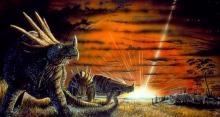We all remember the elementary school videos showing the animated dinosaurs all foraging, going about their rather Disney-like lives (even T-Rex looked kind of friendly). There's a streak in the sky, all of the harmless-looking creatures look over their shoulders, mild curiosity registering on their lip-less faces. There's a flash of white and then a pleasant narrator explains what's happened without actually having to show the placid dinosaurs incinerated. Of course, the truth is that the age of the dinosaur was incredibly violent, natural selection more at play than at any other time in history; biodiversity being a fraction of what it was after the last ice age (of course, we're working on changing that, too). What's much less certain is how, and why the age of the dinosaurs came to a close. A recent discovery in Montana, may have unearthed the answer.
What isn't disputed is that an asteroid did slam into the Yucatan peninsula of present-day Mexico about 65 million years ago, in the Cretaceous Period. What scientists do disagree on is whether that was the catalyst of the dinosaurs mass extinction, or whether dinosaur species were already on the decline, or even extinct, by the time the asteroid hit earth. According to those that believe the asteroid extinction theory, any dinosaur that couldn't fly or burrow into the earth was wiped out by the impact and subsequent climatic disruptions. Incidentally, this is what allowed mammals as an animal kingdom to survive, as they were primarily still a burrowing, rodent-like collection of species. Avian dinosaurs were able to quickly relocate, en masse. The land-bound creatures, however, were killed; if not by the initial impact, then by subsequent freezing from a nearly global cloud of smoke and ash that blotted out the sun for many hundreds of years and the volcanic activity and earthquakes that were sparked by the catastrophic impact.
In southeastern Montana is the Hell Creek Formation, an area known for incredibly rich deposits of fossilized bones and other evidence from the Cretaceous through Paleocene Eras. Most notable within this range of time, represented in the striations of rock, clay, and sediment, is the Cretaceous Tertiary Boundary, or the K-T Boundary. The K-T Boundary is the "extinction zone", illustrated by heightened levels of iridium and quartz, the moment in history at which the asteroid hit earth and dramatically changed climate, weather, and volcanic activity. No fossilized remains have even been found within 3 meters of the K-T Boundary, implying that dinosaurs did not exist at this time, until now.
The youngest dinosaur ever discovered, the brow horn of a young triceratops, has been discovered 13 cm below the K-T Boundary, indicating that the animal was alive right up until the moment of the asteroid's impact. What this means for prehistoric science is still uncertain, and those in the scientific community that doubt dinosaur's existence around the K-T Boundary have yet to respond. However, it seems that there is greater truth in that elementary school video of the friendly dinosaurs and their untimely demise.
